Abstract
Experiments on man-made flawed rock-like materials are applied extensively to study the mechanical behaviour of rock masses as well as crack initiation modes and crack coalescence types. A large number of experiments on specimens containing two or three pre-existing flaws were previously conducted. In the present work, experiments on rock-like materials (formed from a mixture of sand, plaster, limestone and water at mass ratio of 126:9:9:16) containing multiple flaws subjected to uniaxial compression were conducted to further research the effects of the layout of pre-existing flaws on mechanical properties, crack initiation modes and crack coalescence types. Compared with previous experiments in which only three types of cracks were found, the present experiments on specimens containing multiple flaws under uniaxial compression revealed five types of cracks, including wing cracks, quasi-coplanar secondary cracks, oblique secondary cracks, out-of-plane tensile cracks and out-of-plane shear cracks. Ten types of crack coalescence occurred through linkage among wing cracks, quasi-coplanar secondary cracks, oblique secondary cracks, out-of-plane shear cracks and out-of-plane tensile cracks. Moreover, the effects of the non-overlapping length and flaw angle on the complete stress–strain curves, the stress of crack initiation, the peak strength, the peak strain and the elastic modulus were also investigated in detail.




































Similar content being viewed by others
References
Bobet A, Einstein HH (1998) Fracture coalescence in rock-type materials under uniaxial and biaxial compression. Int J Rock Mech Min Sci 35(7):863–888
Li YP, Chen LZ, Wang YH (2005) Experimental research on pre-cracked marble under compression. Int J Solids Struct 42(9–10):2505–2516
Park CH, Bobet A (2009) Crack coalescence in specimens with open and closed flaws: a comparison. Int J Rock Mech Min Sci 46(5):819–829
Park CH, Bobet A (2010) Crack initiation, propagation and coalescence from frictional flaws in uniaxial compression. Eng Fract Mech 77(14):2727–2748
Sagong M, Bobet A (2002) Coalescence of multiple flaws in a rock-model material in uniaxial compression. Int J Rock Mech Min Sci 39(2):229–241
Sahouryeh E, Dyskin AV, Germanovich LN (2002) Crack growth under biaxial compression. Eng Fract Mech 69(18):2187–2198
Shen B (1995) The mechanism of fracture coalescence in compression–experimental study and numerical simulation. Eng Fract Mech 51(1):73–85
Shen B, Stephansson O, Einstein HH, Ghahreman B (1995) Coalescence of fractures under shear stresses experiments. J Geophys Res 100(B4):5975–5990
Wong RHC, Chau KT (1998) Crack coalescence in a rock-like material containing two cracks. Int J Rock Mech Min Sci 35(2):147–164
Wong LNY, Einstein HNY (2006) Fracturing behavior of prismatic specimens containing single flaws. In: Golden Rocks 2006, the 41st US Symposium on Rock Mechanics (USRMS)
Wong LNY, Einstein HH (2009a) Crack coalescence in molded gypsum and Carrara marble: part 1. Macroscopic observations and interpretation. Rock Mech Rock Eng 42(3):475–511
Wong LNY, Einstein HH (2009b) Systematic evaluation of cracking behavior in specimens containing single flaws under uniaxial compression. Int J Rock Mech Min Sci 46(2):239–249
Wong RHC, Chau KT, Tang CA, Lin P (2001) Analysis of crack coalescence in rock-like materials containing three flaws—part I: experimental approach. Int J Rock Mech Min Sci 38(7):909–924
Yang SQ, Yang DS, Jing HW, Li YH, Wang SY (2012) An experimental study of the fracture coalescence behaviour of brittle sandstone specimens containing three fissures. Rock Mech Rock Eng 45(4):563–582
Zhou XP (2005) Localization of deformation and stress–strain relation for mesoscopic heterogeneous brittle rock materials under unloading. Theor Appl Fracture Mech 44(1):27–43
Acknowledgments
This work was supported by the National Natural Science Foundation of China (nos. 51325903, 51279218 and 51078371).
Author information
Authors and Affiliations
Corresponding author
Rights and permissions
About this article
Cite this article
Zhou, X.P., Cheng, H. & Feng, Y.F. An Experimental Study of Crack Coalescence Behaviour in Rock-Like Materials Containing Multiple Flaws Under Uniaxial Compression. Rock Mech Rock Eng 47, 1961–1986 (2014). https://doi.org/10.1007/s00603-013-0511-7
Received:
Accepted:
Published:
Issue Date:
DOI: https://doi.org/10.1007/s00603-013-0511-7




